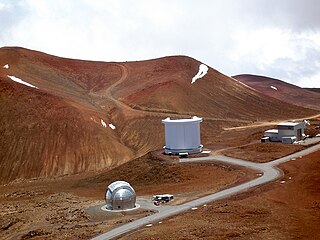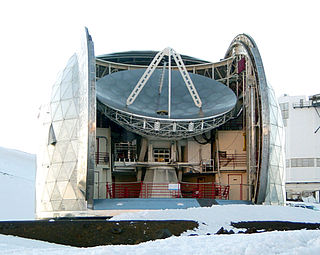Related Research Articles

Robert Woodrow Wilson is an American astronomer who, along with Arno Allan Penzias, discovered cosmic microwave background radiation (CMB) in 1964. The pair won the 1978 Nobel Prize in Physics for their discovery.
The discovery of cosmic microwave background radiation constitutes a major development in modern physical cosmology. In 1964, US physicist Arno Allan Penzias and radio-astronomer Robert Woodrow Wilson discovered the cosmic microwave background (CMB), estimating its temperature as 3.5 K, as they experimented with the Holmdel Horn Antenna. The new measurements were accepted as important evidence for a hot early Universe and as evidence against the rival steady state theory as theoretical work around 1950 showed the need for a CMB for consistency with the simplest relativistic universe models. In 1978, Penzias and Wilson were awarded the Nobel Prize for Physics for their joint measurement. There had been a prior measurement of the cosmic background radiation (CMB) by Andrew McKellar in 1941 at an effective temperature of 2.3 K using CN stellar absorption lines observed by W. S. Adams. Although no reference to the CMB is made by McKellar, it was not until much later after the Penzias and Wilson measurements that the significance of this measurement was understood.

The James Clerk Maxwell Telescope (JCMT) is a submillimetre-wavelength radio telescope at Mauna Kea Observatory in Hawaii, US. The telescope is near the summit of Mauna Kea at 13,425 feet (4,092 m). Its primary mirror is 15 metres across: it is the largest single-dish telescope that operates in submillimetre wavelengths of the electromagnetic spectrum. Scientists use it to study the Solar System, interstellar dust and gas, and distant galaxies.
Clover would have been an experiment to measure the polarization of the Cosmic Microwave Background. It was approved for funding in late 2004, with the aim of having the full telescope operational by 2009. The project was jointly run by Cardiff University, Oxford University, the Cavendish Astrophysics Group and the University of Manchester.

The Caltech Submillimeter Observatory (CSO) was a 10.4-meter (34 ft) diameter submillimeter wavelength telescope situated alongside the 15-meter (49 ft) James Clerk Maxwell Telescope (JCMT) at Mauna Kea Observatories. It was engaged in submillimeter astronomy, of the terahertz radiation band. The telescope closed on September 18, 2015. The telescope is set to be dismantled and its site remediated in the near future as part of the Mauna Kea Comprehensive Management Plan.

The Submillimeter Array (SMA) consists of eight 6-meter (20 ft) diameter radio telescopes arranged as an interferometer for submillimeter wavelength observations. It is the first purpose-built submillimeter interferometer, constructed after successful interferometry experiments using the pre-existing 15-meter (49 ft) James Clerk Maxwell Telescope and 10.4-meter (34.1 ft) Caltech Submillimeter Observatory as an interferometer. All three of these observatories are located at Mauna Kea Observatory on Mauna Kea, Hawaii, and have been operated together as a ten element interferometer in the 230 and 345 GHz bands. The baseline lengths presently in use range from 16 to 508 meters. The radio frequencies accessible to this telescope range from 194–408 gigahertz (1.545–0.735 mm) which includes rotational transitions of dozens of molecular species as well as continuum emission from interstellar dust grains. Although the array is capable of operating both day and night, most of the observations take place at nighttime when the atmospheric phase stability is best.
Antarctic Submillimeter Telescope and Remote Observatory, or AST/RO, was a 1.7 meter diameter off-axis telescope for research in astronomy and aeronomy at wavelengths between 0.2 and 2 mm. The instrument operated between 1994 and 2005 at the South Pole with four heterodyne receivers and three acousto-optical spectrometers. It was replaced by the 10-m South Pole Telescope.

Owens Valley Radio Observatory (OVRO) is a radio astronomy observatory located near Big Pine, California (US) in Owens Valley. It lies east of the Sierra Nevada, approximately 350 kilometers (220 mi) north of Los Angeles and 20 kilometers (12 mi) southeast of Bishop. It was established in 1956, and is owned and operated by the California Institute of Technology (Caltech). The Owens Valley Solar Array portion of the observatory has been operated by New Jersey Institute of Technology (NJIT) since 1997.
The Combined Array for Research in Millimeter-wave Astronomy (CARMA) was an astronomical instrument comprising 23 radio telescopes, dedicated in 2006. These telescopes formed an astronomical interferometer where all the signals are combined in a purpose-built computer to produce high-resolution astronomical images. The telescopes ceased operation in April 2015 and were relocated to the Owens Valley Radio Observatory for storage.

Llano de Chajnantor Observatory is the name for a group of astronomical observatories located at an altitude of over 4,800 m (15,700 ft) in the Atacama Desert of northern Chile. The site is in the Antofagasta Region approximately 50 kilometres (31 mi) east of the town of San Pedro de Atacama. The exceptionally arid climate of the area is inhospitable to humans, but creates an excellent location for millimeter, submillimeter, and mid-infrared astronomy. This is because water vapour absorbs and attenuates submillimetre radiation. Llano de Chajnantor is home to the largest and most expensive astronomical telescope project in the world, the Atacama Large Millimeter Array (ALMA). Llano de Chajnantor and the surrounding area has been designated as the Chajnantor Science Reserve by the government of Chile.

The Atacama Submillimeter Telescope Experiment (ASTE) is a 10-meter-diameter antenna built by Mitsubishi Electric as a preprototype for ALMA.

Submillimeter Wave Astronomy Satellite is a NASA submillimetre astronomy satellite, and is the fourth spacecraft in the Small Explorer program (SMEX). It was launched on 6 December 1998, at 00:57:54 UTC, from Vandenberg Air Force Base aboard a Pegasus XL launch vehicle. The telescope was designed by the Smithsonian Astrophysical Observatory (SAO) and integrated by Ball Aerospace, while the spacecraft was built by NASA's Goddard Space Flight Center (GSFC). The mission's principal investigator is Gary J. Melnick.
Hydrogen isocyanide is a chemical with the molecular formula HNC. It is a minor tautomer of hydrogen cyanide (HCN). Its importance in the field of astrochemistry is linked to its ubiquity in the interstellar medium.

The cyano radical (or cyanido radical) is a radical with molecular formula CN, sometimes written •CN. The cyano radical was one of the first detected molecules in the interstellar medium, in 1938. Its detection and analysis was influential in astrochemistry. The discovery was confirmed with a coudé spectrograph, which was made famous and credible due to this detection. ·CN has been observed in both diffuse clouds and dense clouds. Usually, CN is detected in regions with hydrogen cyanide, hydrogen isocyanide, and HCNH+, since it is involved in the creation and destruction of these species (see also Cyanogen).

The kinetic inductance detector (KID) — also known as a microwave kinetic inductance detector (MKID) — is a type of superconducting photon detector first developed by scientists at the California Institute of Technology and the Jet Propulsion Laboratory in 2003. These devices operate at cryogenic temperatures, typically below 1 kelvin. They are being developed for high-sensitivity astronomical detection for frequencies ranging from the far-infrared to X-rays.

The Cosmology Large Angular Scale Surveyor (CLASS) is an array of microwave telescopes at a high-altitude site in the Atacama Desert of Chile as part of the Parque Astronómico de Atacama. The CLASS experiment aims to improve our understanding of cosmic dawn when the first stars turned on, test the theory of cosmic inflation, and distinguish between inflationary models of the very early universe by making precise measurements of the polarization of the Cosmic Microwave Background (CMB) over 65% of the sky at multiple frequencies in the microwave region of the electromagnetic spectrum.

The Large Latin American Millimeter Array (LLAMA) is a single-dish 12 m Nasmyth optics antenna which is under construction in the Puna de Atacama desert in the Province of Salta, Argentina, next to the Qubic experiment. The primary mirror accuracy will allow observation from 40 GHz up to 900 GHz. After installation it will be able to join other similar instruments to perform Very Large Base Line Interferometry or to work in standalone mode. Financial support is provided by the Argentinian and Brazilian governments. The total cost of construction, around US$20 million, and operation as well as the telescope time use will be shared equally by the two countries. Construction planning started in July 2014 after the formal signature of an agreement between the main institutions involved.
The Leighton Radio Telescopes are 10.4 meter parabolic dish antennas designed by Robert B. Leighton in the 1970s, which were fabricated on the Caltech campus during the 1970s and 1980s. The telescope surfaces reached an accuracy of 10 microns RMS, allowing observations throughout the millimeter and submillimeter bands. In all, eight of these telescopes were made. They were used as the six elements of the Owens Valley Radio Observatory (OVRO) millimeter interferometer in California, and as single telescopes at the Caltech Submillimeter Observatory in Hawaii and the Raman Research Institute (RRI) at Bangalore, India. In the spring of 2005, the six Leighton telescopes in Owens Valley were moved to a high mountain site in the White Mountains to form the core of the CARMA array of 25 telescopes. The CARMA array was decommissioned in 2015 at which time the Leighton telescopes were moved back to OVRO, where they are now being repurposed for different projects including the CO Mapping Array Pathfinder (COMAP), the Event Horizon Telescope (EHT), and various transient detection projects.
References
- 1 2 "Thomas G. Phillips". Los Angeles Times. Los Angeles Times Communications LLC. August 14, 2022. Retrieved 9 February 2023.
- 1 2 3 4 5 6 Clavin, Whitney (August 2022). "Obituary: Thomas G. Phillips (1937-2022)". Bulletin of the American Astronomical Society. 54. doi: 10.3847/25c2cfeb.f81cdc99 . Retrieved 9 February 2023.
- 1 2 3 Steiger, Walter R. "A Brief History of the Caltech Submillimeter Observatory". California Institute of Technology. Retrieved 9 February 2023.
- ↑ "Thomas G. Phillips". Memorials. The International Society of Infrared, Millimeter, and Terahertz Waves. Retrieved 9 February 2023.
- 1 2 3 4 5 Siegel, Peter H. (2012). "Terahertz Pioneer: Thomas G. Phillips "The Sky Above, the Mountain Below"". IEEE Transactions on Terahertz Science and Technology. 99: 1–7. doi:10.1109/TTHZ.2012.2211353 . Retrieved 10 February 2023.
- ↑ Phillips, T. G.; Jefferts, K. B. (August 1973). "A low temperature bolometer heterodyne receiver for millimeter wave astronomy". Review of Scientific Instruments. 44: 1009–1014. Bibcode:1973RScI...44.1009P. doi:10.1063/1.1686288 . Retrieved 9 February 2023.
- ↑ Phillips, T. G.; Jefferts, K. B.; Wannier, P. G. (November 1973). "Observation of the J = 2 TO J = 1 Transition of Interstellar CO at 1.3 Millimeters". Astrophysical Journal. 186: L19–L22. Bibcode:1973ApJ...186L..19P. doi:10.1086/181348 . Retrieved 9 February 2023.
- ↑ Wilson, R. W.; Jefferts, K. B.; Penzias, A. A. (July 1970). "Carbon Monoxide in the Orion Nebula". Astrophysical Journal. 161: L43–L44. Bibcode:1970ApJ...161L..43W. doi: 10.1086/180567 . Retrieved 10 February 2023.
- ↑ Phillips, T. G.; Huggins, P. J.; Neugebauer, G.; Werner, M. W. (November 1977). "Detection of submillimeter (870 µm) CO emission from the Orion molecular cloud". Astrophysical Journal Letters. 217: L161–L164. Bibcode:1977ApJ...217L.161P. doi:10.1086/182561 . Retrieved 10 February 2023.
- ↑ Phillips, T. G.; Huggins, P. J.; Kuiper, T. B. H.; Miller, R. E. (June 1980). "Detection of the 610 micron (492 GHz) line of interstellar atomic carbon". Astrophysical Journal Letters: L103–L106. Bibcode:1980ApJ...238L.103P. doi: 10.1086/183267 . Retrieved 10 February 2023.
- ↑ Phillips, T. G.; Woody, D. P. (1982). "Millimeter- and submillimeter-wave receivers". Annual Review of Astronomy and Astrophysics. 20: 285–321. Bibcode:1982ARA&A..20..285P. doi:10.1146/annurev.aa.20.090182.001441 . Retrieved 10 February 2023.
- ↑ "Herschel Science Team". European Space Agency. Retrieved 18 February 2023.
- ↑ "APS Fellow Archive". APS Fellow Archive. American Physical Society. Retrieved 9 February 2023.
- ↑ "Joseph Weber Award for Astronomical Instrumentation". Joseph Weber Award for Astronomical Instrumentation. American Astronomical Society. Retrieved 9 February 2023.
- ↑ "The Paris Observatory awards its Doctor Honoris Causa for 2014". Centre de recherche en astronomie et astrophysique. Observatoire de Paris. Retrieved 9 February 2023.